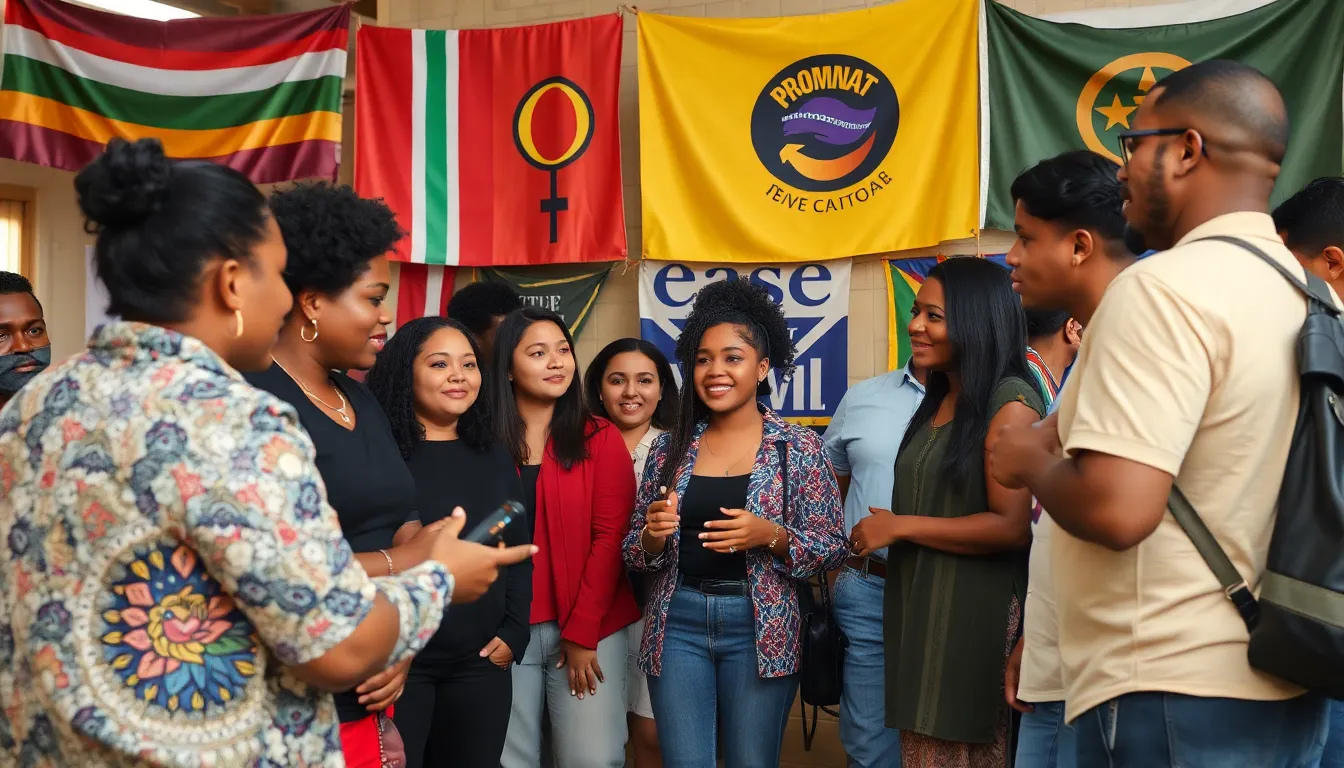Table of Contents
ToggleIn an increasingly interconnected world, embracing diverse perspectives has never been more crucial. Different backgrounds, experiences, and viewpoints enrich conversations and foster innovation. They challenge the status quo and spark creativity, leading to solutions that might otherwise remain undiscovered.
Understanding and valuing diverse perspectives isn’t just a moral imperative; it’s a strategic advantage. Organizations that prioritize inclusivity often see improved performance and greater employee satisfaction. By cultivating an environment where varied opinions are welcomed, they unlock the full potential of their teams. This article explores the importance of diverse perspectives and how they can transform personal and professional landscapes.
Understanding Diverse Perspectives
Diverse perspectives encompass the range of different backgrounds, experiences, and viewpoints people bring to discussions and problem-solving scenarios. Recognizing and valuing these perspectives fosters inclusive environments that drive innovation and creativity.
Definition and Importance
Diverse perspectives represent the multitude of viewpoints stemming from various identities, such as race, gender, culture, and socio-economic status. Embracing these perspectives enhances discussions, challenges assumptions, and generates innovative solutions. Research shows that organizations with diverse teams exhibit higher performance levels, improved decision-making, and greater employee satisfaction. Fostering an environment that prioritizes diversity not only reflects societal values but also presents a strategic advantage in a globalized market.
Key Components of Diversity
- Demographic Diversity: Involves differences in age, race, gender, and ethnicity. These variations bring unique experiences and insights.
- Cognitive Diversity: Incorporates varied ways of thinking, problem-solving, and processing information. Diverse cognitive approaches lead to innovative solutions.
- Experiential Diversity: Consists of different life experiences, education backgrounds, and career paths. Shared and contrasting experiences enrich discussions and deepen understanding.
- Cultural Diversity: Encompasses distinct cultural beliefs, practices, and values. This component fosters respect and appreciation for varied worldviews.
- Social Diversity: Includes differences in sexual orientation, disability status, and socio-economic background. Social diversity broadens the scope for inclusive policies and practices.
Recognizing these components enables organizations and individuals to actively promote and utilize diverse perspectives for enhanced collaboration and productivity.
Historical Context of Diverse Perspectives

Diverse perspectives have developed over centuries, shaped by significant events and intellectual movements. Understanding this historical context provides insight into the importance of embracing varied viewpoints today.
Evolution of Thought
Diverse perspectives evolved through key philosophical and social movements. The Enlightenment introduced ideas of individual rights and equality, promoting discussions around various identities. The 19th and 20th centuries saw the rise of feminism, civil rights, and multiculturalism, expanding awareness of gender, race, and cultural identities. Each movement intertwined, emphasizing the need for inclusivity and broader narratives. Contemporary thought continues to build on these foundations, integrating diverse perspectives in discussions about justice, equity, and societal change.
Influential Movements
Several influential movements contributed to the recognition of diverse perspectives.
- The Civil Rights Movement: Fought against racial segregation and discrimination, advancing the rights of African Americans and emphasizing the importance of equality in society.
- Feminist Movements: Highlighted gender inequality, advocating for women’s rights and challenging traditional roles, leading to greater awareness of gender-based issues.
- LGBTQ+ Rights Movement: Campaigned for acceptance and equality for individuals across diverse sexual orientations, urging broader understanding and respect for different identities.
- Postcolonial Movements: Addressed the impact of colonialism on various cultures, promoting the importance of recognizing and valuing indigenous perspectives.
These movements shaped public discourse and highlighted the need for inclusion in discussions about rights, opportunities, and representation.
Current Applications of Diverse Perspectives
Diverse perspectives are increasingly integrated into various fields, enhancing experiences and outcomes. Key areas where these perspectives play a vital role include education, the workplace, and media and arts.
In Education
Diverse perspectives in education foster a rich learning environment. They encourage critical thinking by exposing students to varying viewpoints and cultures. Incorporating diverse curricula promotes inclusivity and relevance, aligning lessons with the experiences of all students. For instance, studies show that culturally relevant pedagogy increases student engagement and academic performance, as it reflects their identities and experiences. Collaborative learning environments that emphasize group work further enhance understanding by allowing students to learn from each other’s diverse backgrounds.
In the Workplace
Diverse perspectives in the workplace drive innovation and improve problem-solving. Organizations that prioritize diversity witness enhanced team collaboration and creativity, ultimately leading to better business outcomes. For instance, McKinsey’s research found that companies in the top quartile for gender diversity were 25% more likely to achieve above-average profitability. Bringing together diverse talents encourages unique solutions to complex challenges, ultimately impacting employee satisfaction. Additionally, promoting a culture of inclusion allows employees from various backgrounds to feel valued, contributing to higher retention rates.
In Media and Arts
Diverse perspectives in media and arts shape narratives that reflect society’s complexities. Representing different identities and experiences enriches storytelling, allowing audiences to connect with varied themes and characters. For example, films and books that explore diverse cultural backgrounds often achieve critical acclaim and resonate with broader audiences. Moreover, artistic expression that incorporates diverse perspectives encourages dialogue on social issues, fostering empathy and understanding. This representation in media influences public perception and promotes the importance of inclusivity in all forms of communication and art.
The Benefits of Embracing Diverse Perspectives
Embracing diverse perspectives leads to numerous benefits in various domains. These advantages contribute to enhanced innovation, creativity, and overall problem-solving capabilities.
Innovation and Creativity
Innovation thrives in environments where diverse perspectives are present. Teams that comprise individuals with varied backgrounds foster unique ideas and approaches. This diversity encourages out-of-the-box thinking, which is essential for developing innovative products and services. For instance, companies like Apple and Google consistently attribute their pioneering technology to diverse teams. Diverse perspectives also stimulate creativity by exposing individuals to different cultural viewpoints and experiences, resulting in fresh solutions to complex challenges.
Enhanced Problem Solving
Enhanced problem-solving emerges as a key benefit of embracing diverse perspectives. Teams that incorporate a range of viewpoints tend to analyze issues from multiple angles, leading to more comprehensive solutions. Studies show that diverse teams perform better in problem-solving tasks compared to homogeneous groups. For example, a report from McKinsey highlights that organizations with diverse teams show improved decision-making capabilities. This effectiveness stems from the combination of cognitive diversity and varied experiences, allowing teams to explore alternative strategies and minimize blind spots.
Challenges in Acknowledging Diverse Perspectives
Acknowledging diverse perspectives presents significant challenges that can hinder effective integration. Two major issues arise: stereotypes and bias, along with communication barriers.
Stereotypes and Bias
Stereotypes and bias distort perceptions of individuals from different backgrounds. Stereotypes, which are oversimplified beliefs about groups, can lead to inaccurate assessments and assumptions. For example, assumptions regarding a person’s abilities based on their race or gender may diminish their credibility or impact in discussions. Similarly, bias, whether explicit or implicit, affects decision-making processes. Research shows that unconscious bias can influence hiring practices, promotions, and team dynamics, thus limiting opportunities for underrepresented groups.
Communication Barriers
Communication barriers further complicate the acknowledgment of diverse perspectives. These barriers arise from differences in language, cultural norms, and varying communication styles. For instance, idiomatic expressions common in one culture might be misunderstood by individuals from another. Additionally, differing levels of assertiveness and responsiveness can lead to misinterpretations during discussions. Studies indicate that organizations with clear communication strategies experience fewer conflicts and foster an environment that values diverse inputs, improving overall engagement and collaboration.
Embracing diverse perspectives is crucial in navigating today’s complex landscape. It not only enriches conversations but also drives innovation and fosters a culture of inclusion. By valuing different viewpoints, organizations can unlock creative solutions and enhance overall performance.
Moreover, recognizing the unique contributions of individuals from various backgrounds leads to improved collaboration and productivity. As the world continues to evolve, the importance of diverse perspectives will only grow.
Organizations and individuals alike must prioritize inclusivity to harness the full potential of diverse ideas and experiences. This commitment to diversity will pave the way for a more innovative and empathetic future.







